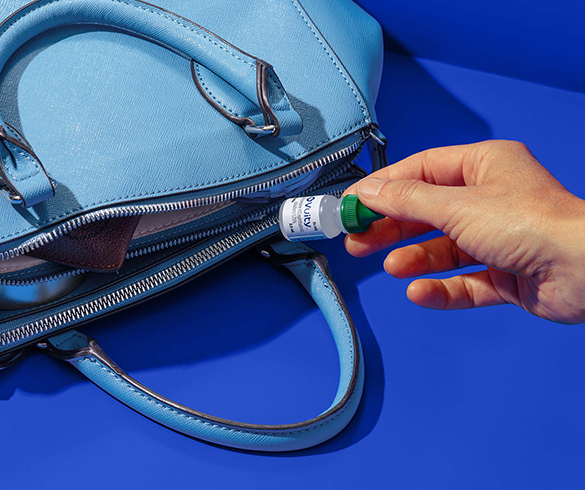
Managing Blurry Near Vision As You Age
If you find yourself using a brighter light to read, holding your favorite book at arm’s length, or squinting to see up close, you are not alone. Approximately 128 million people in the United States have presbyopia, or age-related blurry near vision, a common and progressive eye condition affecting most people over 40.1,2
As you hit middle age, the lenses of your eyes become less flexible, and you may find it more difficult to see up close.3 Presbyopia can be diagnosed through a basic eye exam by an optometrist or ophthalmologist.4
Toni Wright is one of the many people who experiences age-related blurry near vision. “As I’ve gotten older, my vision has changed, and it has become almost impossible to see clearly up close unless I wear my readers. After speaking with my doctor, I learned that I have presbyopia. Realizing that I needed to start using readers showed me how important it was to address this condition.”
Until now, some of the options to manage presbyopia have been reading glasses, contact lenses or surgery. The U.S. Food and Drug Administration recently approved the first and only prescription eye drop to treat presbyopia, or age-related blurry near vision, in adults. The once-daily prescription eye drop called VUITY™ (pilocarpine hydrochloride ophthalmic solution) 1.25%, improves near and intermediate vision without impacting distance vision. Do not use VUITY if you are allergic to any of the ingredients. See additional Important Safety Information below.
As you age, it’s important to care for your eye health. The following are some easy steps you can take:
- Visit your eye doctor regularly. Eye exams can help uncover age-related eye conditions like presbyopia.5 It’s a normal part of getting older and important to spot early on.
- Give your eyes a rest. It’s easy to get lost in reading or work when you’re looking at screens all day. Setting a timed reminder can help give your eyes a break every 20 minutes. To reduce eye strain, try the 20-20-20 rule: Every 20 minutes, look 20 feet in front of you for 20 seconds.6
- Eat a healthy, balanced diet. Your diet should include a variety of proteins, dairy, fruits, and vegetables. Eating fish high in omega-3 fatty acids, such as salmon, tuna, and sardines can also help your eyes.7
- Protect your eyes from the sun. Wear quality sunglasses that offer good UV protection to protect your eyes from harmful solar radiation.8 Don’t just save them for the summer months – it’s important to wear them even on cloudy days and during winter months.
Scheduling an appointment with an eye care professional is the first step, and if you’re experiencing age-related blurry near vision, talk to your eye care professional to see if VUITY is right for you. Visit VUITY.com to learn more.
This release is sponsored by Allergan, an AbbVie company.
US-VUI-210084 11/21
VUITY Use and Important Safety Information
USE
VUITY™ (pilocarpine hydrochloride ophthalmic solution) 1.25% is aprescription eye drop used to treat age-related blurry near vision (presbyopia) in adults.
IMPORTANT SAFETY INFORMATION
- Do not use VUITY if you are allergic to any of the ingredients.
- Use caution when driving at night or performing hazardous activities in poor lighting.
- Temporary problems when changing focus between near and distant objects may occur. Do not drive or use machinery if vision is not clear.
- Seek immediate medical care if you experience any sudden vision loss.
- If you wear contact lenses, they should be removed prior to VUITY use. Wait 10 minutes after dosing before reinserting contact lenses.
- Do not touch the dropper tip to any surface as this may contaminate the contents.
- If more than one topical eye medication is being used, the medicines must be administered at least 5 minutes apart.
- The most common side effects are headache and eye redness. These are not all the possible side effects of VUITY.
Please see full Prescribing Information at VUITY.com or call 1-833-MY-VUITY.
You are encouraged to report negative side effects of prescription drugs to the FDA. Visit www.fda.gov/medwatch or call 1-800-FDA-1088.
References:
- Zebardast N, Friedman DS, Vitale S. The prevalence and demographic associations of presenting near-vision impairment among adults living in the United States. Am J Opthalmol. 2017;174: 134–144.
- Mayo Clinic. Presbyopia Symptoms & causes. mayoclinic.org. https://www.mayoclinic.org/diseases-conditions/presbyopia/symptoms-causes/syc-20363328. Accessed November 2021.
- American Optometric Association. Adult Vision: 41 to 60 Years of Age. aoa.org. https://www.aoa.org/healthy-eyes/eye-health-for-life/adult-vision-41-to-60-years-of-age?sso=y. Accessed November 2021.
- American Optometric Association. Healthy Eyes. Eye and Vision Conditions. Presbyopia. https://www.aoa.org/healthy-eyes/eye-and-vision-conditions/presbyopia?sso=y. Accessed November 2021.
- American Optometric Association. Adult Vision: 41 to 60 Years of Age. aoa.org. https://www.aoa.org/healthy-eyes/eye-health-for-life/adult-vision-41-to-60-years-of-age?sso=y. Accessed November 2021.
- Kiersten Boyd. American Academy of Ophthalmology. Computers, Digital Devices and Eye Strain. aao.org. https://www.aao.org/eye-health/tips-prevention/computer-usage. Accessed November 2021.
- Harvard Medical School. Top foods to help protect your vision. health.harvard.edu. https://www.health.harvard.edu/staying-healthy/top-foods-to-help-protect-your-vision. Accessed November 2021.
- American Optometric Association. Ultraviolet (UV) protection. Aor.org. https://www.aoa.org/healthy-eyes/caring-for-your-eyes/uv-protection?sso=y. Accessed November 2021.
Source:
Allergan, an AbbVie Company















